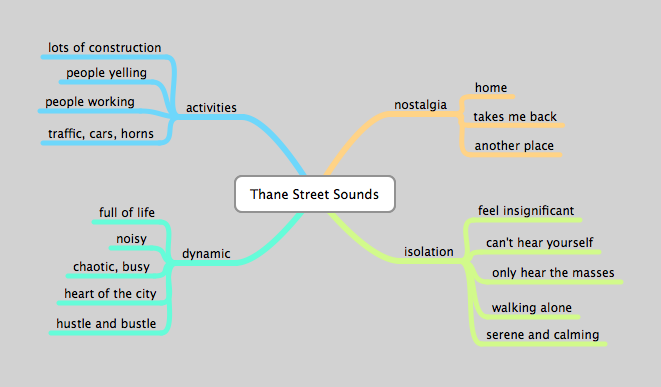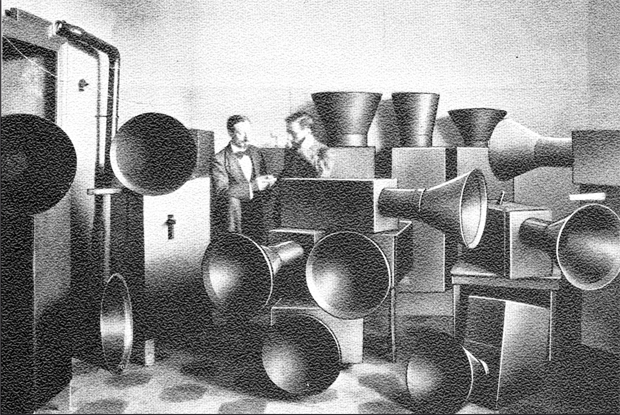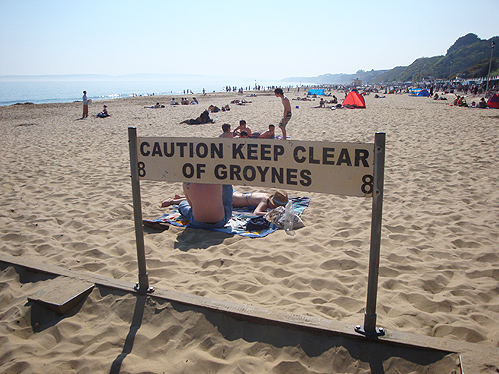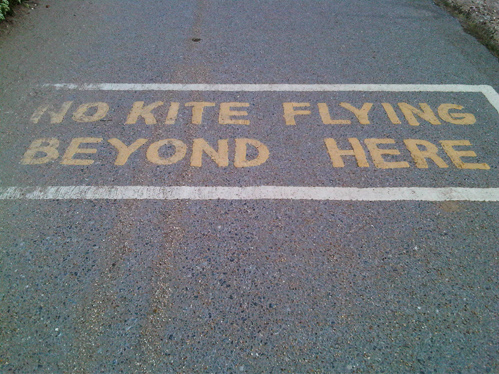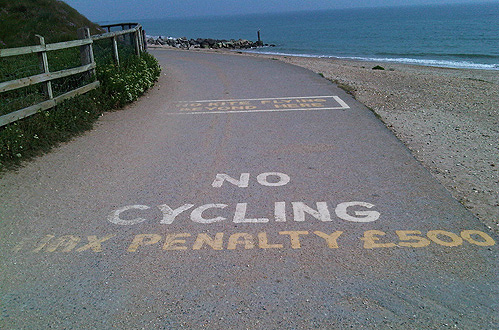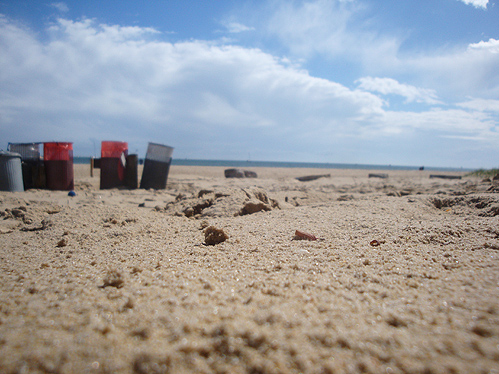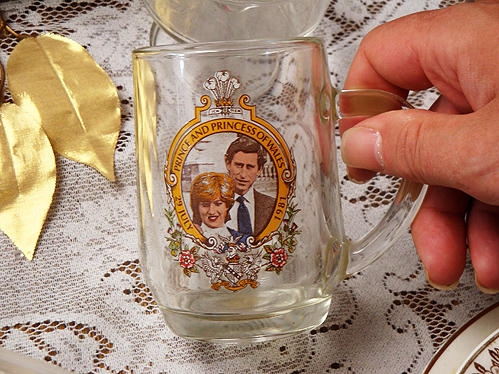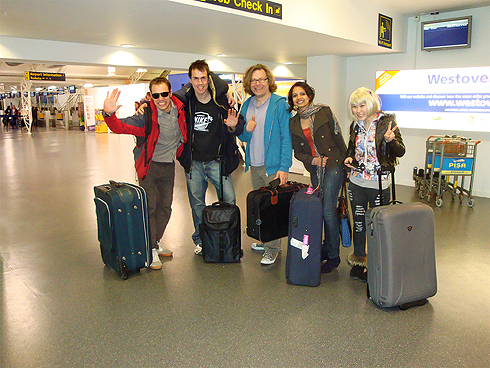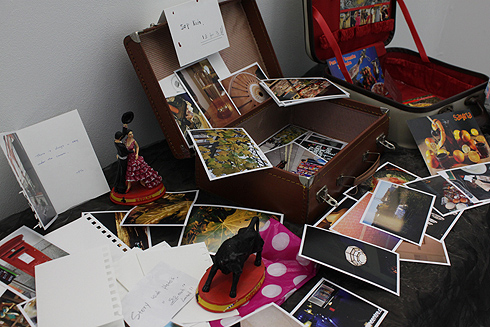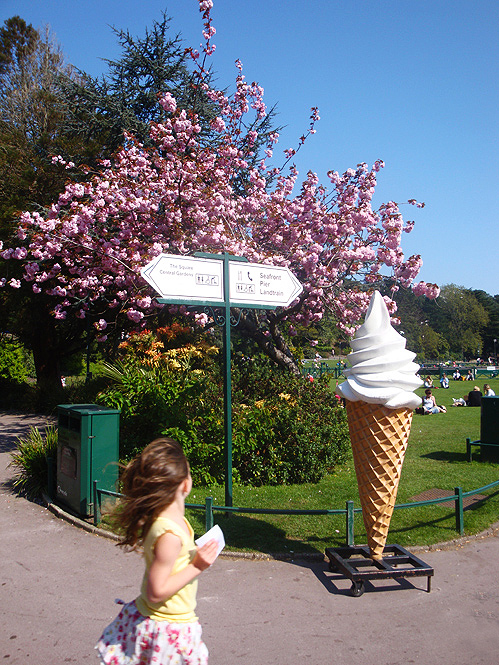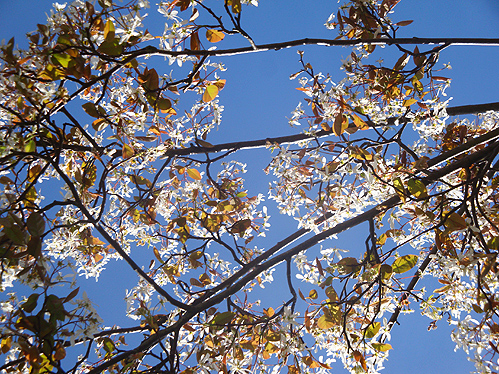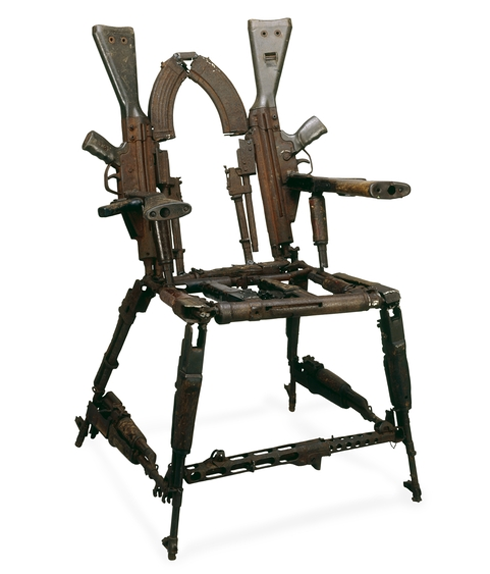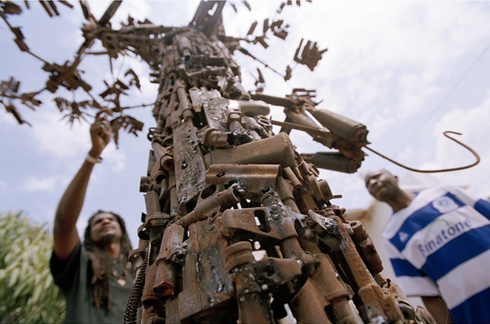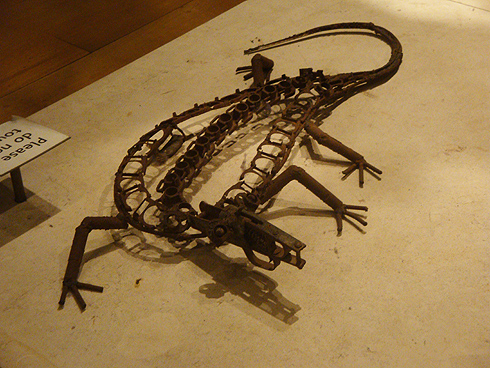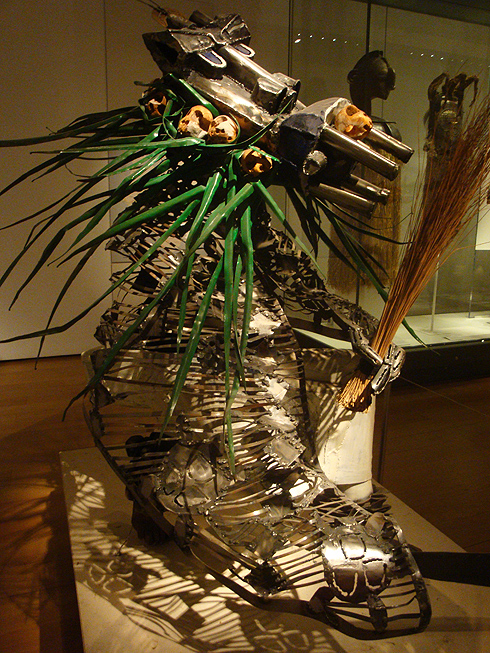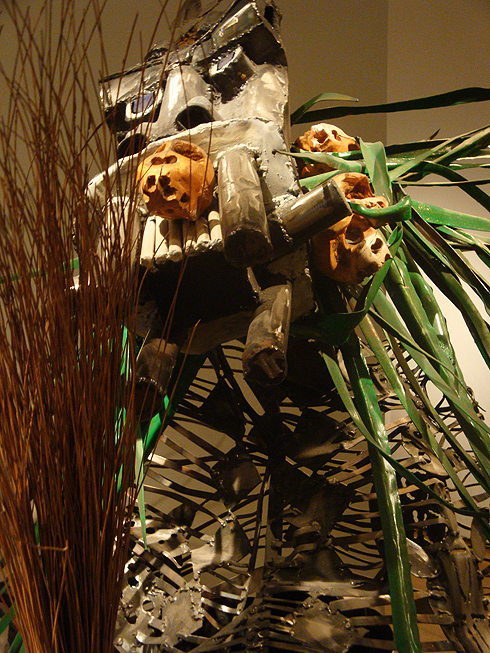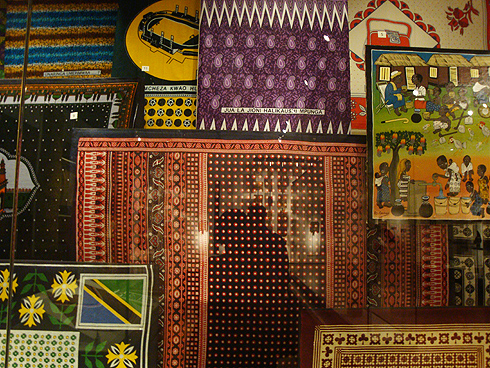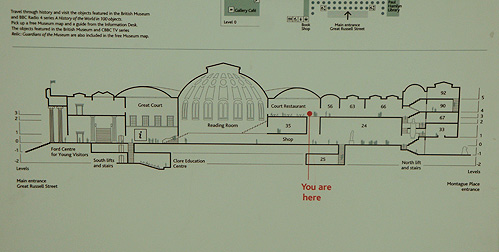How to buy alcohol in the UK (if you are not old-looking)
1. Ensure that all friends and acquaintances travelling with you have their ID proving that they are above 18. If even one person in the group does not have it, make them go away or act like you don't know them for the next 20 mins. 2. Enter the supermarket from where you plan to buy the alcohol.
3. Pick up your chosen beverage, snacks and supplies.
4. Go to the counter.
5. At the till, keep your ID ready and be positive.
6. If you are lucky, they will accept your ID. If not they will inform you that they only accept UK identification and/or an INTERNATIONAL driver's license. In these sad cases, my Indian driving license, Indian PAN card, and student ID from the United Nations is deemed suspect. (All 3 id's prove that I'm 25 with a photo).
7. If you're ID is rejected due it not being issued by an EU or UK authority (United Nations is not counted) do not fret. Most importantly do not argue. Do not tell them that you cannot possible carry your passport everywhere with you. Do not tell them that other stores have accepted this ID several times before. Do not tell them that your passport is with the Italian embassy and what are you supposed to do now?
8. Be positive. After all, this proves that you look below 18 (Yeah right).
9. Go to an off-license store. They accept Id's not from the UK/EU. They are open till late and have more choices anyway. The End.
Surrealism in Graphic Design
An overview of the talk on surrealism in graphic design by Rick Poynor, founder of eye magazine.
Rick Poynor's talk about Surrealism in graphic design was inspiring and refreshingly idealistic. He is an influential writer on visual culture and founder of Eye magazine. He started off by saying that surrealism is about transforming the world, a kind of 'poetic expression' and document of the 'marvellous'. To surrealists' the term marvellous is something transformative, beautiful and uncanny.

Katastrofa by Roman Cieślewicz (1961). From the archive of the Moravian Gallery in Brno. [Image Source].
Poynor argues that the clinical and grid-based designs being mass-produced today in the UK are a symptom of a much larger social control. The mobile phone that is supposed to free you is actually putting you into a node. He suggested that we should avoid 'submitting to the grid.' Instead he showed us brilliant examples of Polish and Czech graphic designers who created unforgettable images using surrealist elements. There are various ways to create this surrealist feeling: random juxtaposition, doubles, repetition, and of course the use of dolls. The images should make you feel uncomfortable, repelled and at the same time attracted to the work.
From the archive of the Moravian Gallery in Brno. [Image Source].
This image above by Jan Švankmajer is an excellent example of the kind of surrealist work Poynor emphasized in the talk and his earlier exhibition about the same topic.
^ by French artist Marion Bataille. From the archive of the Moravian Gallery in Brno. [Image Source].
Poynor goes on to mention that none of this may be "true" surrealist art since a true surrealist has sworn into the surrealist manifesto. You could say that this use of surrealist imagery in advertising and movie posters is a commodification of such ideals. We cannot deny however that surrealism, even as a term, has diffused into the mainstream, though not necessarily in the way that the original surrealist intended the term and imagery to be used.
Finally Poynor laments the absence of disruptive graphic design in UK and London, especially in the London tube. By encouraging students like us to pursue our individual expression, he hopes for a 'visual culture that reflects humanity in all its complexity.'
Reference
Poynor, R (2011). Surrealism in Graphic Design. Arts University College Bournemouth. 13th May.
Design Observer Blogs. (2010) Uncanny: Surrealism and Graphic Design. Available from: http://observersroom.designobserver.com/rickpoynor/uncanny.html [Accessed 15th May 2011].
Moravian Gallery in Brno. (2010). Uncanny: Surrealism in Graphic Design by Rick Poynor. Available from http://www.moravska-galerie.cz/moravska-galerie/vystavy-a-program/aktualni-vystavy/2010/cosi-tisniveho-surrealismus-a-graficky-design.aspx Accessed [15th May 2011].
Mumbai Noise
I spoke to several people who had never visited India, and collected their reactions to recorded street sounds from Thane. I asked them how the sound made them feel and what it reminded them of.
Noise is 'part of the experience of the urban' (Barry, 2000, p.170). I am interested in how it can be used to transport people to an other place, to create a visual experience with sound alone. In his essay on Noise the author Andrew Barry (2000, p.168) says:
For Russolo, far from seeking to block out this noise, modern composers should listen to it and learn from it. In doing so they should not attempt to produce pure sounds, which were, in his view, 'estranged from life'.
The author states that though during futurist Luigi Russolo's time the modern city was a noisy place, today 'it is increasingly blocked out, dampened down or simply displaced' (Barry, 2000, p.170). It is easy to disagree since in a developing city such as Mumbai we suffer from dangerously high noise levels, a problem that is getting increasingly difficult to contain.
Russolo's futurist manifesto The Art of Noise inspired me to study the topic further. It is fascinating to read his account from 1913, where he literally predicts the rise in popularity of electronica, techno, trance and industrial rock (Russolo, 1967, p.5):
Nowadays musical art aims at the shrilliest, strangest and most dissonant amalgams of sound. Thus we are approaching noise-sound. This revolution of music is paralleled by the increasing proliferation of machinery sharing in human labor. In the pounding atmosphere of great cities as well as in the formerly silent countryside, machines create today such a large number of varied noises that pure sound, with its littleness and its monotony, now fails to arouse any emotion.
[Image Source] ^Russolo's mechanical orchestra.
This lead me to compare the unedited urban Mumbai sounds with Russolo's work with the mechanical orchestra, a relevant example is Risveglio Di Una Città 1913:
It has opened a whole new world in terms of how I can edit raw street sound and the various ways I can integrate it within a space. Using similar fantastical "noise-music" from Mumbai I can create an atmosphere and place that is inherent to the city.
Reference
Ananthakrishnan, G. (2010). Mumbai Diwali Decibel Levels: Cold Comfort. Nov.6th 2010. Digital Journo. [online]. Available from: http://digitaljourno.wordpress.com/2010/11/06/mumbai-diwali-decibel-levels-cold-comfort/ Accessed 14th May 2011.
Barry, A (2000). Noise. In: Pile, S. and Thrift, N. (eds.) City A-Z. London: Routledge.
Naik, Y. and Khera, D. (2011). IIT-B Demands Noise Barriers. Mumbai Mirror. [online]. April 17th 2011. Available from: http://www.mumbaimirror.com/article/2/2011041720110417030951301232b713d/IITB-demands-noise-barriers.html [Accessed: 13th May 2011].
Russolo, L. (1967). The Art of Noise, futurist manifesto 1913. [pdf]. Something Else Press. Available from: http://www.ubu.com/historical/russolo/index.html [Accessed 13th May 2011].
Rebello, S and Lohade. U. (2011). Sound and fury in Mumbai. Hindustan Times Mumbai. [online] April 20, 2011. Available from: http://www.hindustantimes.com/StoryPage/Print/687364.aspx [Accessed 12th May 2011].
Wikipedia (2011). The Art of Noises. Available from: http://en.wikipedia.org/wiki/The_Art_of_Noises [Accessed 13th May 2011].
A Short History of the Shadow
In this book the author explains the history and meaning behind the shadow in western art. Beginning with the shadow's role in the origin of painting, Victor I.Stoichita covers its symbolic significance across history, from Renaissance painters to Picasso, Warhol and even Piaget's child psychology. Over time he explains how the shadow came to represent negativity, or how the shadow was demonized. The excerpt below is from the first chapter which deals with the earliest representations of the shadow, infused with magical properties, and at times representing the soul.
"...As Maspero reminds us in his classic study, the shadow was how the Egyptians first visualized the soul (ka). In this case it was a 'clear shadow, a colored projection, but aerial to the individual, reproducing every one of his features'. And the black shadow (khaibit), having been regarded in even earlier times as the very soul of man, was subsequently considered to be his double." [pg 19]
An interesting point brought up was the difference between a shadow in sunlight and a shadow at night. He says "..a shadow in sunlight denotes a moment in time and no more than that, but a nocturnal shadow is removed from the natural order of time, it halts the flow of progress." This is relevant because day versus night is a recurring theme in my work since October last year. It also reminded me of the work Tobari no Akari, which to me signified stillness and a frozen moment in time due to the use of nocturnal shadows.
The author's comparison of specular representations with the shadow is also relevant to my work. For example mirrors and reflections in water represent a double (mimesis or likeness) of the real object or person, whereas the shadow can represent the other: "The frontal relationship with the mirror is a relationship with the same, just as the relationship with the profile was a relationship with the other." Giorgio Vasari, The Origin of Painting, 1573, fresco Casa Vasari, Florence.[pg.41]
The book lead me to question the role and significance of the shadow in my work. I've used the shadow in my first installation as a negative symbol to represent the darker hidden city. Whereas in collaborative work such as Tobari no Akari and concept work Beedi Leaf the significance is contextual and at times open to interpretation. Similarly the author underlines the changing meaning of the shadow, "...we could say that to Lippi the shadow as a symbol, is an interminably interpretable symbol." [pg.82]
Although my study of the shadow as a signifier will continue, I cannot find much information about the history of the shadow in Indian or Eastern Art. Besides brief excerpts on shadow puppetry I've discovered only limited information on the significance behind this ancient tradition.
Update: More on the significance of the shadow in the east here.
Reference
Stoichita,V (1997). A Short History of the Shadow. London: Reaktion Books Ltd.
Turner,C and Stoichita,V (2007). A Short History of the Shadow: Interview with Victor I. Stoichita. Cabinet Magazine Issue 24 [online] Available from http://www.cabinetmagazine.org/issues/24/stoichita.php [Accessed 26th April 2011].
Warner, M (2007). Darkness Visible Cabinet Magazine Issue 24. [online] Available from http://www.cabinetmagazine.org/issues/24/Warner.php [Accessed 26th April 2011]
Laundry Room City
![]() Participants: Michael Moore, Samantha Else, Baran Saragul, Rina Miyake, Ben O'Shea, Taro Morimoto, Yi Lu, Tanya and me.
Photos by Samantha Else and me. Paper-mache dolls and houses by Yi Lu. Video and installation set-up by Aditi Kulkarni.
Participants: Michael Moore, Samantha Else, Baran Saragul, Rina Miyake, Ben O'Shea, Taro Morimoto, Yi Lu, Tanya and me.
Photos by Samantha Else and me. Paper-mache dolls and houses by Yi Lu. Video and installation set-up by Aditi Kulkarni.
Since I live in a building full of artists, I decided to invite everyone to one of my spontaneous experiments with the Mumbai videos. Using objects I found in the laundry room such as pieces of thermocol, cardboard boxes, chairs, clothespins and piles of yellow pages I created a crowded, urban space. No sound was used since I couldn't find speakers. After the first thirty minutes of discussion and feedback, people started adding and subtracting to the work, literally "playing" with the objects I had collected and even adding their own. Overall it was exciting since I felt it was relevant to the process of literally "building" a city which is unplanned and crowded like Mumbai, filled with so many different people. Eventually Yi Lu added her own work to the installation; fantasy objects such as houses and dolls made of paper-mache.
This event lead to the collaborative work Tobari no Akari by Taro Morimoto, Yi Lu and me. It also formed the base for my later experimentation with City Memories. Sam and Michael came up with the suggestion to use lego, which lead to Lego city #1.
More on Mumbai Lights
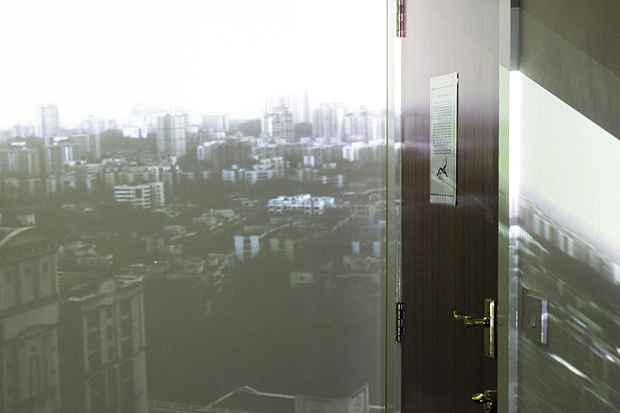
 ^Texture: Projecting on the floor carpet.
^Texture: Projecting on the floor carpet.
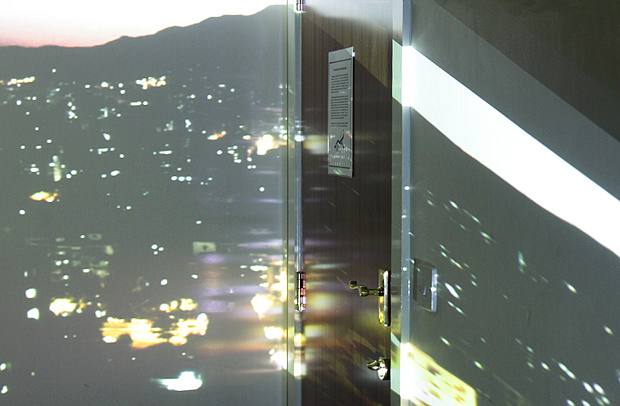 ^Distorted night video on the same door.
^Distorted night video on the same door.
 ^Texture: Regular projector produces visible lines and pixels that cover the wall.
^Texture: Regular projector produces visible lines and pixels that cover the wall.
This is a series of experiments on how Mumbai city lights and sound interact with familiar spaces around me. Earlier I used overlapping projections and shadows to express a conflicting bipolarity within Mumbai. As I attempt to integrate relevant space and sound into the experience, location is one of the most important factors that come into play. One option is to use the projections and video in a suitable outdoor space, and the other is to use a place personal and familiar to me, referencing my memories of the city and my identity as a Mumbaikar. Here I've experiments on the walls, ceiling and floor carpet, observing the effects of the night videos and day videos on various coloured surfaces and corners. The results encouraged me to try more spontaneous variations, rather than make just one well-planned installation.
Installations & Inspiration
Gerry Judah Paintings.
Fire with Fire (2010) by Isabelle Hayeur 3 channels video installation. Video projection of 15 minutes playing in continuous loop. 3 Blu-ray players, 3 video projectors. 112 West Hastings Street, Vancouver. Fire with Fire has been commissioned by The Vancouver 2010 Cultural Olympiad. Curator : Marlene Madison.
Rosa Barbara at Tate Modern. Article about the work here.
Show Homes and Display Desire (2007) by Vesna Pavlović. "Within the “Display, Desire” installation, the prints simultaneously function as images of display and display of images. Strange details of the American home are exposed, through the language of cinema and mechanisms of projection. The projection of black and white transparencies onto semi-transparent Plexiglas screens suggest the plastic quality of the interiors, and within the overlapping projection spaces, the images transform, exploring possible representations of the photographic medium itself."
Art Direction & Visuals: Deniz Kader – Candaş Şişman, Music & Sound Design: Görkem Şen, Project Management: Erdem Dilbaz, Modelling: Gökhan Uzun – Can Dinlenmiş (prospektif.org)
JR's (French Street Artist) TED Prize Wish: Use Art to turn the world Inside Out.
Group Critique
During the group critique I spoke about projecting the filmed cityscape outdoors, and the importance of capturing the essence of the city. Leigh Clarke reacted with a wide range of comments about the work. His main point was that the sound was more powerful than the time-lapse video since it allowed the audience to imagine a larger, more ambiguous space.
He also mentioned that my background as a privileged member of society, and the subsequent "god-like" perspective referred to the panopticon and I should be cautious about the meanings inferred from such choices. Tracey Emin's Folkstone work was mentioned in relation to illustrating a place by using one powerful symbolic object. Leigh Clarke felt that I should focus on a particular object or section of the city instead of trying to describe the entire "forest." He commented that I needed to have an original view of the city rather than something which has been seen before. Ai Weiwei's work Sunflower Seeds 2010 was also mentioned, however I am of the opinion that the work has little relation to mine since I'm looking at sharing the darker, hidden city. In terms of capturing essence however the work is relevant due to the clever play on porcelain versus sunflower seeds, and the issue of handcrafted versus mass-industrialization.
Overall the critique was motivating and provocative because he challenged my project at every level. I explored whether I could go ahead without the visual aspect altogether and looked at various installation concepts that would center around sound as a medium. Another important conclusion was that giving the audience too much information reduced the impact of the work. Overall I realized much more experimentation and research is needed before I can confidently defend my work.
Reference:
Bentham, J (1791). Panopticon Or the Inspection House Vol1 [ebook]. University of Lausanne. Available from: http://books.google.com/ebooks [Accessed 23rd April].
Calvino, I (1997). Invisible Cities. New Edition. London: Minerva.
Emin, T (2008) Baby Things [online] Available from http://www.folkestonetriennial.org.uk/2011-event/artists/2008-tracey-emin/ [Accessed 23rd April 2011].
Foucault, M (1977). Discipline & Punish: The Birth of the Prison [online] Translated from French by Alan Sheridan. Available online from http://www.cartome.org/foucault.htm [Accessed 23rd April 2011].
Kennedy, M (Jan 2011). Ai Weiwei's Sunflower Seeds to go on sale at Sotheby's [online] Available from http://www.guardian.co.uk/artanddesign/2011/jan/26/ai-weiwei-sunflower-seeds-sothebys?INTCMP=SRCH [Accessed 23rd April 2011].
Tate Modern (2010). The Unilevel Series: Ai Weiwei [online] Available from http://www.tate.org.uk/modern/exhibitions/unileverseries2010/default.shtm [Accessed 23rd April 2011].
Place-Making
Notes on urban memory, place-making and its relation to the interpretation of the city in contemporary art and architecture.
During my tutorial with Ronnie Inglis we spoke about the meaning behind the autobiographical trend in my work and further topics of study, especially in relation to place-making. We discussed my previous areas of interest such as the city and fantasy, collective versus personal urban memories, place-making in relation to site-specific art, use of the shadow, and representing extremes. He directed me towards the book History of the Shadow which greatly influenced my work in the following weeks. The topic of Genius loci is relevant because I am interested in shooting my projections in outdoor locations. According to Thompson (2003, p.67) 'the Romans believed that places, like people, had inner spirits that determined their essences,' and similarly I was interested in this essence of Mumbai. Thompson also mentions that for genius loci to be useful rather than a mere magical notion it should be a combination of 'character, local distinctiveness and ecosystem' (2003, p.69). This lead to the idea of representing the city as a fictionalized creation, in the same way a writer creates a fictional character.
And a thing's character changes and develops over time. This can happen slowly or through abrupt events. The reading made me realize that Mumbai has not developed slowly or without trauma. It has grown in bursts and starts. Several traumatic events such as the '93 bombings and the more recent 26/11 Taliban attack have affected the city. We could argue however, that despite these severe shocks the essence of the city remains the same. According to Norberg-Schulz (cited in Thompson, 2003, p.70) "places can change, sometimes rapidly, but this does not necessarily mean that the genius loci changes or gets lost."
An excellent example of the genius loci being kept intact by an architect is the above landscape park Landschaftspark Duisburg-Nord by Peter Latz. The place was 'traumatized by industrialization and deindustrialization' and the architect built upon 'its existing character, creating fern gardens in ore bunkers and making their mass concrete walls into facilities for rock climbers' (Thompson, 2003, p.72). This connects to my idea of using appropriate objects, materials and sites that are relevant to the trauma and violence of the city.
^Cotton 56, Polyester 84 is a play about how the failed Mumbai Mills are getting converted into malls and entertainment complexes. Citizen's groups demand that the land should be converted into open parks and low cost housing, but slowly and surely all mill land will be sold to builders (Shanbag, 2006).
^Another abandoned Mumbai Mill.
As sites these are beautiful and tragic places that express this violent and crushing conflict between the here and the elsewhere, the undesirable and the desired. I can only pursue this direction further once I am back in India. At the same time it brings me to question my interest in these places, since my knowledge of these events is purely historical, through media reports and local people's opinions. At this point in my practice I would prefer to express issues and places that I have personally and directly experienced.
Another important aspect of place is memory, which is in turn closely related to history. Historical buildings such as the mills compounds and their replacements are part of a general history of the city. Individual memories have a completely different flavour. In the book City of Collective Memory the author underlines this difference by proposing that history and memory are bipolar attributes because history is linear and memory non-linear (Boyer, 2001, p.67). Collective memory is 'a current of continuous thought still moving in the present, still part of a group's active life, and these memories are multiple and dispersed, spectacular and ephemeral, not recollected and written down in one unified story' (Boyer, p.67).
Another fascinating point is that this urban memory is 'an antimuseum and not localizable' (Boyer, p.68). This means that my earlier work using popular landscapes and landmarks was a reference to history, a revision of a recognizable historical reality. It is also a reference to memory since I have taken various historical elements and placed them in a contemporary context. Now that I am using scenes that are not famous or instantly recognizable such as the Thane landscape I am removing "historical" elements from the work.
The next topic is framing. We frame the place or city 'by travel, in the theater, at the museum, from the cinema, through its architectural compositions' (Boyer, p.70). The panorama as a framed image is questionable - the city of the panorama is criticized for its 'rational scientific methods,' 'describable pasts' and 'predictable futures' (Boyer, p.68). The author criticizes common recycled views of the city saying 'We have learned to gaze upon the city as artifact through illustrated portfolios and architectural guidebooks that have their own procedures for characterizing place and tradition' (Boyer, p.69).
And finally I'll quote Victor Burgin (1996, p.7) who says that 'we cannot know a 'city', only those of its places we come to frequent.'
Reference
Boyer, C (2001). The City of Collective Memory, Its Historical Imagery and Architectural Entertainments. MIT Press.
Burgin, V. (1996). Some Cities. London: Reaktion Books Ltd.
Thompson, I. (2003). What use is the genius loci? In: Menin, S.(eds). Constructing Place, Mind and Matter. London: Routledge. pp.66-76.
Pile, S. and Thrift, N. (2000). City A-Z. London: Routledge
Wikipedia. (2011). Urbanism [online] Available from http://en.wikipedia.org/wiki/Urbanism. [Accessed 23rd April 2011].
Modern Drawings
Drawings of life in the city, and abstract dream cities. From the exhibition Picasso to Julie Mehretu, modern drawings from the British Museum collection [7th Oct 2010 to 25th April 2011].
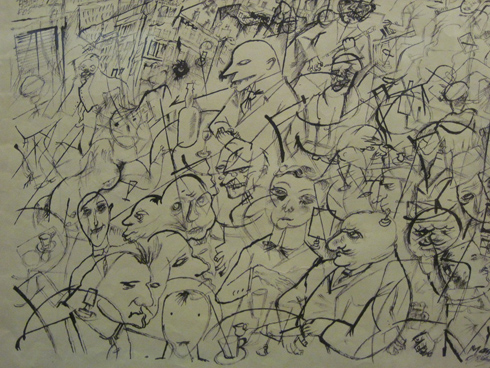 People in a Cafe, 1917 by George Grosz. [Image Source]
People in a Cafe, 1917 by George Grosz. [Image Source]
 Dreamland Tower, Coney Island 1912 by David Milne (1882-1953). [Image Source]
Dreamland Tower, Coney Island 1912 by David Milne (1882-1953). [Image Source]
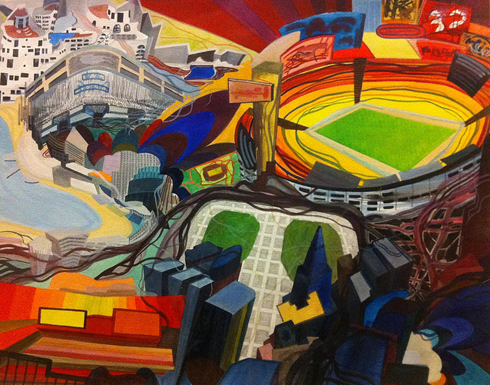 Untitled (Pacific No. 32, weekend), 1998 by Franz Ackermann. [Image Source]
Untitled (Pacific No. 32, weekend), 1998 by Franz Ackermann. [Image Source]
 Untitled (City Abstraction) 1912 by Abraham Walkowitz. [Image Source]
Untitled (City Abstraction) 1912 by Abraham Walkowitz. [Image Source]
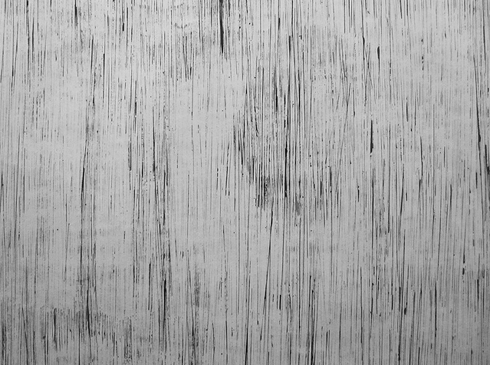 Vertical Lines 1953 by Kazuro Nakamura. [Image Source]
Vertical Lines 1953 by Kazuro Nakamura. [Image Source]
 Untitled by Lawrence Weiner (born 1942) [Image Source]
Untitled by Lawrence Weiner (born 1942) [Image Source]
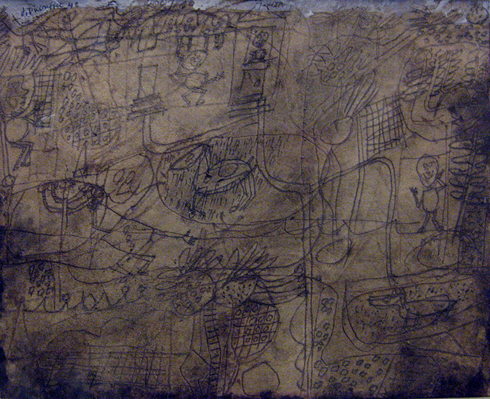 Grotesque Landscape in Yellow 1949 by Jean Dubaffet (1401-85) Pen and ink on yellow watercolour. [Image Source]
Grotesque Landscape in Yellow 1949 by Jean Dubaffet (1401-85) Pen and ink on yellow watercolour. [Image Source]
Update 4th May: I've only included work that is relevant to my project on representing the atmosphere of the city. In my journey towards representing the violence between the fantasy and the real within Mumbai, I've noticed a trend towards abstraction especially with the increasing use of shadows and reflections within the installation. These drawings capture this urban feeling in their own individual expressionist ways.
Spain
This was a four day group project focussed on creating work based on our course inputs on artifice, site and place. During our presentation we spoke about our week long "trip" to spain, showing photographs, postcards and souvenirs from our travels. We also recounted interesting anecdotes about the journey. In the evening we organized an event around the "Spain" trip, exhibiting prints of our tourist photographs, postcards and a video of our journey to the airport. We also sold "Spanish" food, beer and candy to recover the cost of printing and attract a wider audience.
 At the Loarre Castle, in Huesca, Spain
At the Loarre Castle, in Huesca, Spain
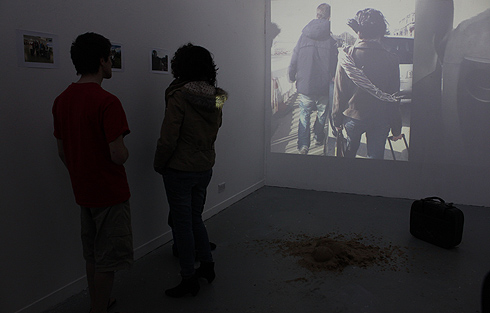 Video collage of airport trip.
Video collage of airport trip.
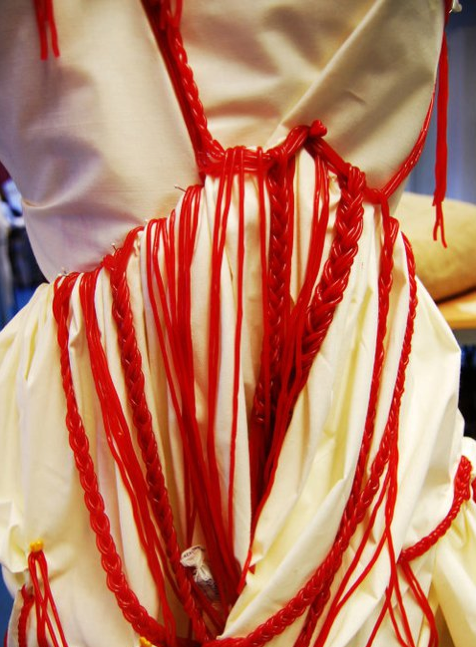 Detail of costume made from Spanish candy by Mimi He.
Photo collage by Rodrigo Munoz and Aditi Kulkarni. Photos and videos by Taro Marimoto and Mimi He.
Detail of costume made from Spanish candy by Mimi He.
Photo collage by Rodrigo Munoz and Aditi Kulkarni. Photos and videos by Taro Marimoto and Mimi He.
Reactions to the work were varied. Some commented that the spanish trip was obviously fake and therefore made the audience feel like they were listening to a lie, also making them uncomfortable. Most of the audience laughed throughout the presentation, which was our main aim, to entertain and tell a good story. Others enjoyed the "tongue-in-cheek" retelling of our experience. Overall we created an artifical journey by producing digital collages of real pictures taken by one of our group members in Spain, and pictures of us digitally added into these "real" locations. We also aimed to comment on the tourist experience by bringing in cliche souvenirs such as the spanish bull. Overall, the audience felt that video was the most believable evidence of such a trip.
Museum Visit
A trip to London ended up at the British museum. Most of the work I found inspiring were from the Africa rooms:
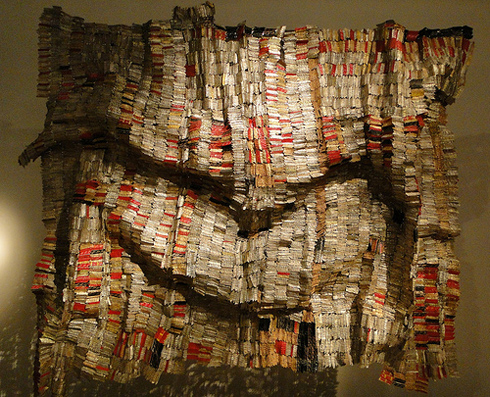
Man's Cloth. Recycled metal foil bottle-neck wrappers, copper wire. By El Anatsui, Ghana, 1998-2001. Image 1 Source. Detail photograph taken at the British Museum April 2011.
Throne of weapons, by Kester, Maputo, Mozambique, 2001. Made of decommissioned weapons from the Mozambican civil war in 1992. Exhibited at Room 25 Africa at the British Museum (April 2011).
Tree of Life Made by Kester, Hilario Nhatugueja, Fiel dos Santos and Adelino Serafim Maté. Maputo, Mozambique, 2004. Photo © 2005 Christian Aid / David Rose.
Part of the sculpture Tree of Life Made by Kester, Hilario Nhatugueja, Fiel dos Santos and Adelino Serafim Maté. Maputo, Mozambique, 2004. Photo by Aditi Kulkarni at the British Museum Room 25: Africa.
Otobo (Hippo) masquerade, made by Sokari Douglas Camp, 1995. Steel, paint, wood and palm stem brooms. British Museum April 2011. More details.
Glazed stoneware figure of a judgement group, Ming Dynasty, China, 16th century. Photo taken at British Museum, Asian Gallery.
Housepost, Iatmul people, Sepik River, Papua New guinea, 1900-1950.
Kanga display, Africa room, British Museum, April 2011.
The British Museum
A day trip to London ended up at the British museum, it's huge, and impossible to honestly finish it in one visit. The section on "Africa" was the best, and within it the Throne of weapons by Mozambican artist Cristovao Canhavato (Kester). The chair sculpture is made from decommissioned weapons from the civil war in Mozambique.

A detailed post on the art work I found inspiring is here.
Dark Stuff
I stumbled on the work Dark Stuff (2008) while looking at random postcards being sold at the British Museum in London. Tim Noble and Sue Webster had created an impressive image inspired by Egyptian mummies, and it motivated me to look for more of their work. Then I found Sunset in Manhattan (2003).
Dark Stuff, 2008 by Tim Noble and Sue Webster 189 mummified animals (67 field mice, 5 adult rats, 42 juvenile rats, 44 garden shrews, 1 fox, 1 squirrel, 1 weasel, 13 carrion crows, 7 jackdaws, 1 blackbird, 1 sparrow, 1 robin, 1 toad, 1 gecko, 3 garden snail shells), glue, metal stands, light projector [Visit Image Source]
Sunset over Manhattan, 2003 Cigarette packets, tin cans shot by air gun pellets, wooden bench, light projector 110 x 31 x 75 cm (431/3 x 121/4 x 291/2 in) [Visit Image Source]
Here the use of rubbish combined with light and shadow creates a city that is recognizable as Manhattan, and at the same time makes an important comment about the place itself. At this point in my project I explored the use of objects in my installations and what kind of objects would be relevant to the concept of the fantastical and the real.




